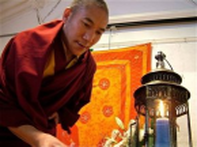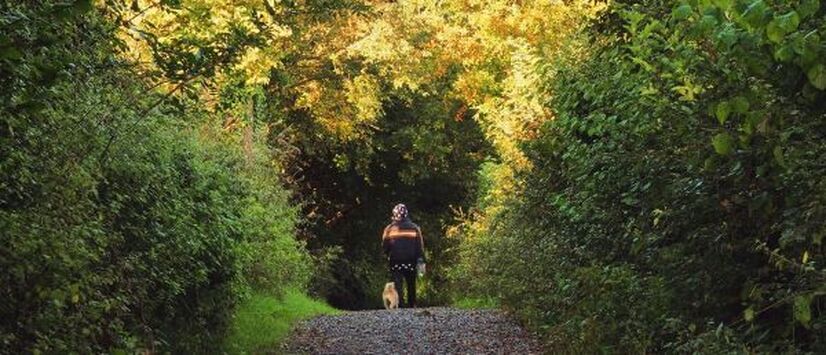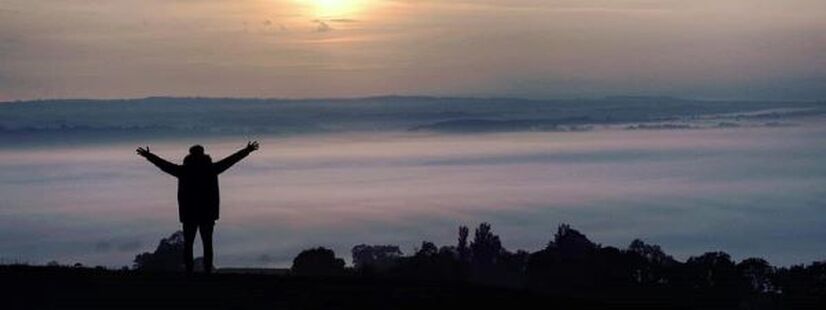Pilgrimage and Glastonbury
'The Purpose'
The start of any pilgrimage would be awareness by potential pilgrims that they felt a need to undertake such a journey. The reasons could be varied but would often include a desire to visit a particular holy or sacred site in order to worship, give honour, seek answers to questions and receive healing and spiritual guidance. Combined with these objectives, would be the satisfaction of the journey itself.
Contemporary Pilgrimage to Glastonbury
There is no longer a firmly established custom for making such a journey and instead, the potential pilgrim will have heard about Glastonbury from friends, books or the internet, which may have sparked the interest. and this is often followed by a strong call to visit the place. Some even leave their previous lives behind and come to live here and are known as 'resident pilgrims', often staying for a few years before moving on.
There is no longer a firmly established custom for making such a journey and instead, the potential pilgrim will have heard about Glastonbury from friends, books or the internet, which may have sparked the interest. and this is often followed by a strong call to visit the place. Some even leave their previous lives behind and come to live here and are known as 'resident pilgrims', often staying for a few years before moving on.
'Planning the Journey'
After having decided upon the pilgrimage and the destination, it is prudent to make some plans for the journey itself. In earlier times, the roads were difficult and dangerous and in most cases, the pilgrims would have sought a group of others to accompany them on the journey. They would also need to plan safe and reliable overnight stops on the way, usually in places set up to specifically accommodate pilgrims.
Contemporary Pilgrimage in Glastonbury
In the past, there would have been a clearly established pattern to the journey. One example today is the pilgrimage to Santiago de Compostela in Spain; with clearly defined maps of the roads to be taken and the recognised rest points at one day’s walking distance apart. Our contemporary pilgrims visiting Glastonbury will have no such clear plan to follow. On the other hand, they have a wealth of information on the internet that was not previously available, such as flights, buses, trains, hotels etc. to help them plan the route.
They also have this website and Glastonbury Online. (Our pilgrims of yore were not so fortunate!)
In the past, there would have been a clearly established pattern to the journey. One example today is the pilgrimage to Santiago de Compostela in Spain; with clearly defined maps of the roads to be taken and the recognised rest points at one day’s walking distance apart. Our contemporary pilgrims visiting Glastonbury will have no such clear plan to follow. On the other hand, they have a wealth of information on the internet that was not previously available, such as flights, buses, trains, hotels etc. to help them plan the route.
They also have this website and Glastonbury Online. (Our pilgrims of yore were not so fortunate!)
'The Journey Itself'
In traditional pilgrimages, the on-foot journey is a vital part of the whole experience and provides an opportunity for meditation and reflection, as we build our connection with the land, ourselves, and the world about us. Walking ten miles a day might be the most that can comfortably be covered. It can therefore take many days, if not weeks to get from home to Glastonbury; the last part of the inbound journey bringing into welcome sight, the goal of Glastonbury Tor.
The Contemporary Pilgrimage
Today, we have a totally different situation whereby travellers from any part of the world can fly to the UK in a matter of hours. The journey from the airport to Glastonbury takes no more than a few hours, whether it is by train, bus or car. In the haste of the journey, there is virtually no time for quiet contemplation. So today, the journey itself plays very little part in the pilgrimage. Perhaps this is a pity. However, even in the relatively short time occupied by the journey today, there is still time for synchronous meetings with other travellers, for extraordinary events to occur and these are often recounted by visitors to the volunteers in our Centre.
Today, we have a totally different situation whereby travellers from any part of the world can fly to the UK in a matter of hours. The journey from the airport to Glastonbury takes no more than a few hours, whether it is by train, bus or car. In the haste of the journey, there is virtually no time for quiet contemplation. So today, the journey itself plays very little part in the pilgrimage. Perhaps this is a pity. However, even in the relatively short time occupied by the journey today, there is still time for synchronous meetings with other travellers, for extraordinary events to occur and these are often recounted by visitors to the volunteers in our Centre.
'Arrival & Welcome'
On arrival at their destination, traditional pilgrims might be greeted by priests of the temple or other guardians of the sacred place. The welcome often includes Information on accommodation and other essential details. plus the process for completing the act of pilgrimage.
Contemporary Pilgrimage in Glastonbury
Unlike sacred places devoted to a specific religion, Glastonbury is a place where a multitude of spiritual paths are represented. The result is a huge variety of shops, courses, workshops, healers and specific sacred sites, covering almost every possible spiritual path. This openness to all paths is one of the attractions of Glastonbury, but it can be very confusing to the first time visitor. In 2007, the Glastonbury Pilgrim Reception Centre was set up to help and support pilgrims and seekers in finding information and resources relevant to their spiritual journey. In 2017, it merged its services with the Tourist Information Centre and the Glastonbury Town Council Information services, all under one roof.
Unlike sacred places devoted to a specific religion, Glastonbury is a place where a multitude of spiritual paths are represented. The result is a huge variety of shops, courses, workshops, healers and specific sacred sites, covering almost every possible spiritual path. This openness to all paths is one of the attractions of Glastonbury, but it can be very confusing to the first time visitor. In 2007, the Glastonbury Pilgrim Reception Centre was set up to help and support pilgrims and seekers in finding information and resources relevant to their spiritual journey. In 2017, it merged its services with the Tourist Information Centre and the Glastonbury Town Council Information services, all under one roof.
'Ceremony in the Sacred Place'
Contemporary Pilgrimage in Glastonbury
In the past, there would have been a very clear practice for pilgrims to follow in order to complete their pilgrimage. In Santiago de Compostela, it is to attend a service in the cathedral, walk behind the great statue of St James, to say a prayer and then to move on. In Glastonbury today, there is no particular recognised practice. There are however, many ways in which the individual pilgrim can complete the visit. It may be a climb of the Tor, a visit to Chalice Well, the White Spring, the Abbey, the Goddess Temple, The Temple of Avalon...or any of our other wonderful sacred sites.
In the past, there would have been a very clear practice for pilgrims to follow in order to complete their pilgrimage. In Santiago de Compostela, it is to attend a service in the cathedral, walk behind the great statue of St James, to say a prayer and then to move on. In Glastonbury today, there is no particular recognised practice. There are however, many ways in which the individual pilgrim can complete the visit. It may be a climb of the Tor, a visit to Chalice Well, the White Spring, the Abbey, the Goddess Temple, The Temple of Avalon...or any of our other wonderful sacred sites.
'Completion'
Contemporary Pilgrimage in Glastonbury
In the days when Glastonbury had a thriving community of Benedictine monks, it would have been possible for the pilgrim to play a part in the life of the Abbey. This was a huge enterprise with its own farms, workshops, library and a whole range of other activities with the pilgrims who chose to stay for some time would have been able to join in the life of this community.
Today, there is no longer a living, working Abbey. There is however, a thriving and active community of resident pilgrims. This community contains an extraordinary number of artists, writers, musicians, therapists and creative people of every sort. The contemporary pilgrim visitor who wants to stay for some time in the town will very soon find a way of making friends with people of similar interests. Regardless of how pilgrims undertake the journey, if they are sensitive to their intuition they will find themselves guided to the correct completion for them.
In the days when Glastonbury had a thriving community of Benedictine monks, it would have been possible for the pilgrim to play a part in the life of the Abbey. This was a huge enterprise with its own farms, workshops, library and a whole range of other activities with the pilgrims who chose to stay for some time would have been able to join in the life of this community.
Today, there is no longer a living, working Abbey. There is however, a thriving and active community of resident pilgrims. This community contains an extraordinary number of artists, writers, musicians, therapists and creative people of every sort. The contemporary pilgrim visitor who wants to stay for some time in the town will very soon find a way of making friends with people of similar interests. Regardless of how pilgrims undertake the journey, if they are sensitive to their intuition they will find themselves guided to the correct completion for them.

Why not call into the Centre and sit with the Glastonbury Unity Candle for awhile? You could also obtain your own and ask the Companion on duty if you could light it from the Mother Candle which resides in its own special space in the Centre. On your return home, your candle will allow you to continue making a connection to Glastonbury and remind you of all the things you experienced and learned.
'Looking after the Sacred Place'
Contemporary Pilgrimage in Glastonbury
In most places of pilgrimage, there are resident attendants or guardians who look after the special places, tend sacred fires and receive offerings and gifts from incoming pilgrims. The cost of looking after these premises are usually met by gifts from grateful visitors.
Before the Reformation, all the buildings were looked after by the Abbey with the town, and its supporting services, complementary to the Abbey. Now, we have a town of some 10,000 people which is both a market town and a town of pilgrimage. There is no one coordinating body, rather a multitude of individuals who run their own businesses and projects, many of them in a role of stewardship in which they care for our special places with some welcome support from our visitors.
The individual enterprises are, in the main, looked after and supported by their own activities, whether they are selling goods and services or by donations and support from the community. This is a totally different way of working from that of the Middle Ages but one that is representative of the new way - what we might call the Aquarian Way - where whole communities are starting to work together.
In most places of pilgrimage, there are resident attendants or guardians who look after the special places, tend sacred fires and receive offerings and gifts from incoming pilgrims. The cost of looking after these premises are usually met by gifts from grateful visitors.
Before the Reformation, all the buildings were looked after by the Abbey with the town, and its supporting services, complementary to the Abbey. Now, we have a town of some 10,000 people which is both a market town and a town of pilgrimage. There is no one coordinating body, rather a multitude of individuals who run their own businesses and projects, many of them in a role of stewardship in which they care for our special places with some welcome support from our visitors.
The individual enterprises are, in the main, looked after and supported by their own activities, whether they are selling goods and services or by donations and support from the community. This is a totally different way of working from that of the Middle Ages but one that is representative of the new way - what we might call the Aquarian Way - where whole communities are starting to work together.
However, should a visiting pilgrim wish to help support places such as ourselves, a donation will always be warmly received. By doing so, you would be following in a tradition of ‘making an offering’, thus helping the Centre to continue to support present and future pilgrims.
'The Return'
Contemporary Pilgrimage in Glastonbury
In the past, the return journey would have been as leisurely as the outward journey, giving ample time to reflect upon the whole experience, but this is not often the case with modern transport. It might therefore be helpful to spend one or two quiet days, once home, in order to contemplate and absorb what has been learnt. The journey of pilgrimage is a symbol in action and for many, it can have profound and lasting effects.
The processes we experience can lead us to a better understanding of our place in the world and our own connection to Spirit. Common effects of pilgrimage can be the solidification of something that is growing in us and brings answers to our questions. Our sense of well-being increases, allowing us to explore deeper into the meaning of our own lives - this ultimately bringing about a process of transformation bringing us nearer towards the goal of realising our own full potential.
However you undertake your journey, blessings on your pilgrimage!
If we can help you, do call in in chat with us.
In the past, the return journey would have been as leisurely as the outward journey, giving ample time to reflect upon the whole experience, but this is not often the case with modern transport. It might therefore be helpful to spend one or two quiet days, once home, in order to contemplate and absorb what has been learnt. The journey of pilgrimage is a symbol in action and for many, it can have profound and lasting effects.
The processes we experience can lead us to a better understanding of our place in the world and our own connection to Spirit. Common effects of pilgrimage can be the solidification of something that is growing in us and brings answers to our questions. Our sense of well-being increases, allowing us to explore deeper into the meaning of our own lives - this ultimately bringing about a process of transformation bringing us nearer towards the goal of realising our own full potential.
However you undertake your journey, blessings on your pilgrimage!
If we can help you, do call in in chat with us.
Bringing the 'P' Word - Will Parsons and Guy Hayward
Will Parsons and Guy Hayward are walking (and singing) their way ever-deeper into Britain on a quest to rediscover and refresh the pilgrimage traditions of this land. Co-founders of The British Pilgrimage Trust, Will, and Guy believe that a renewed tradition of distinctively British physical/spiritual journey-making - open to everyone, with or without religion - could become one of the most powerful and important social movements of 21st Century Britain.
Listen to them explaining about pilgrimage in a way that we can all identify with.
Listen to them explaining about pilgrimage in a way that we can all identify with.







